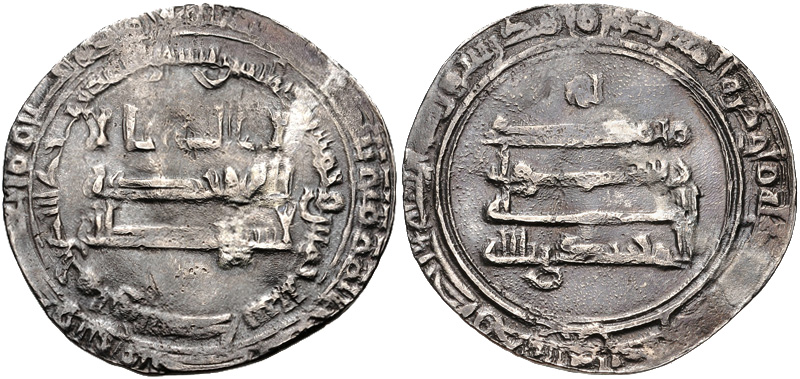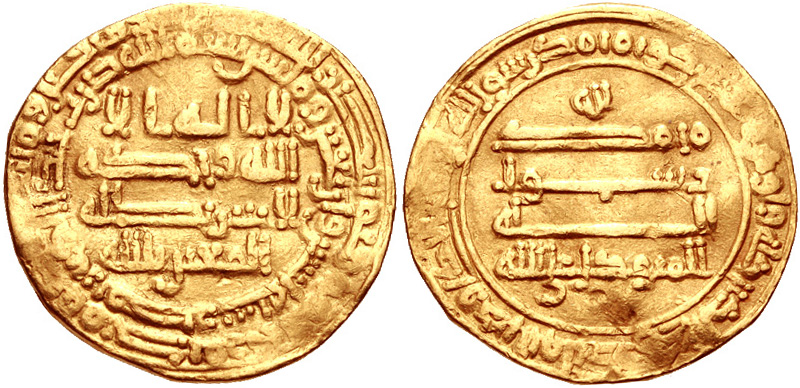|
Al-Muhtadī
Abū Isḥāq Muḥammad ibn al-Wāthiq ( ar, أبو إسحاق محمد بن هارون الواثق; – 21 June 870), better known by his regnal name Al-Muhtadī bi-'llāh (Arabic: , "Guided by God"), was the Caliph of the Abbasid Caliphate from July 869 to June 870, during the "Anarchy at Samarra". Early life Al-Muhtadi was the son of Abbasid caliph al-Wathiq. He was born in 833. Al-Muhtadi's mother was Qurb, a Greek slave. After the death of his father, Caliph al-Wathiq () in August 847, there were some officials who wanted to elect the young al-Muhtadi as caliph, but in the end, their choice fell on his uncle, al-Mutawakkil (). Background Despite the successes of caliph al-Mu'tazz, He could not overcome the main problem of the period: a shortage of revenue with which to pay the troops. The financial straits of the Caliphate had become evident already at his accession—the customary accession donative of ten months' pay for the troops had to be reduced to two for lack ... [...More Info...] [...Related Items...] OR: [Wikipedia] [Google] [Baidu] |
Regnal Name
A regnal name, or regnant name or reign name, is the name used by monarchs and popes during their reigns and, subsequently, historically. Since ancient times, some monarchs have chosen to use a different name from their original name when they accede to the monarchy. The regnal name is usually followed by a regnal number, written as a Roman numeral, to differentiate that monarch from others who have used the same name while ruling the same realm. In some cases, the monarch has more than one regnal name, but the regnal number is based on only one of those names, for example Charles X Gustav of Sweden. If a monarch reigns in more than one realm, they may carry different ordinals in each one, as some realms may have had different numbers of rulers of the same regnal name. For example, the same person was both King James VI of Scotland and King James I of England. The ordinal is not normally used for the first ruler of the name, but is used in historical references once the name i ... [...More Info...] [...Related Items...] OR: [Wikipedia] [Google] [Baidu] |
Umayyad
The Umayyad Caliphate (661–750 CE; , ; ar, ٱلْخِلَافَة ٱلْأُمَوِيَّة, al-Khilāfah al-ʾUmawīyah) was the second of the four major caliphates established after the death of Muhammad. The caliphate was ruled by the Umayyad dynasty ( ar, ٱلْأُمَوِيُّون, ''al-ʾUmawīyūn'', or , ''Banū ʾUmayyah'', "Sons of Umayya ibn Abd Shams, Umayyah"). Uthman ibn Affan (r. 644–656), the third of the Rashidun caliphs, was also a member of the clan. The family established dynastic, hereditary rule with Mu'awiya I, Muawiya ibn Abi Sufyan, long-time governor of Syria (region), Greater Syria, who became the sixth caliph after the end of the First Fitna in 661. After Mu'awiyah's death in 680, conflicts over the succession resulted in the Second Fitna, and power eventually fell into the hands of Marwan I from another branch of the clan. Greater Syria remained the Umayyads' main power base thereafter, with Damascus serving as their capital. The Umayyads c ... [...More Info...] [...Related Items...] OR: [Wikipedia] [Google] [Baidu] |
Turkic Peoples
The Turkic peoples are a collection of diverse ethnic groups of West, Central, East, and North Asia as well as parts of Europe, who speak Turkic languages.. "Turkic peoples, any of various peoples whose members speak languages belonging to the Turkic subfamily...". "The Turkic peoples represent a diverse collection of ethnic groups defined by the Turkic languages." According to historians and linguists, the Proto-Turkic language originated in Central-East Asia region, potentially in Mongolia or Tuva. Initially, Proto-Turkic speakers were potentially both hunter-gatherers and farmers, but later became nomadic pastoralists. Early and medieval Turkic groups exhibited a wide range of both East Asian and West-Eurasian physical appearances and genetic origins, in part through long-term contact with neighboring peoples such as Iranian, Mongolic, Tocharians, Yeniseian people, and others."Some DNA tests point to the Iranian connections of the Ashina and Ashide,133 highlighti ... [...More Info...] [...Related Items...] OR: [Wikipedia] [Google] [Baidu] |
Salih Ibn Wasif
Salih ibn Wasif ( ar, صالح بن وصيف; died January 29, 870) was a Turkic officer in the service of the Abbasid Caliphate. The son of Wasif, a central figure during the Anarchy at Samarra, Salih briefly seized power in the capital Samarra and deposed the caliph al-Mu'tazz in 869, but he was later defeated by the general Musa ibn Bugha and killed in the following year. Early career Salih was the son of Wasif al-Turki, a Turkish general who had risen to prominence during the caliphate of al-Mu'tasim (r. 833–842). Together with his ally, the fellow Turk Bugha al-Sharabi, Wasif had been involved in the assassination of al-Mutawakkil (r. 847–861). During the chaotic period that followed al-Mutawakkil's death (the Anarchy at Samarra, 861–870), Wasif and Bugha were among the principal figures in the events that transpired. They held a strong degree of influence over the central government and were responsible for the downfall of several caliphs and other prominent figures ... [...More Info...] [...Related Items...] OR: [Wikipedia] [Google] [Baidu] |
Sulayman Ibn Abdallah Ibn Tahir
Sulayman ibn Abdallah ibn Tahir ( ar, سليمان بن عبد الله بن طاهر) was a ninth century Tahirid official in the service of the Abbasid Caliphate. He was the last Tahirid governor of Tabaristan, ruling there until he was expelled by the rebellion of al-Hasan ibn Zayd in 864, and was afterwards appointed governor of Baghdad and the Sawad in 869, a position which he held until his death in 879. Governorship of Tabaristan Sulayman was the son of Abdallah ibn Tahir, the governor of Khurasan from 828 until 845. According to Ibn Isfandiyar, he was appointed as governor of Tabaristan in either 851 or 854, and served there on behalf of the Tahirids of Khursasan, under whose jurisdiction the province fell. During his time in Tabaristan, Sulayman came under the influence of his deputy Muhammad ibn Aws al-Balkhi, who was able to appoint members of his family as governors of the cities and districts of the province. These last dealt with the local inhabitants in an extr ... [...More Info...] [...Related Items...] OR: [Wikipedia] [Google] [Baidu] |
Ubaydallah Ibn Abdallah Ibn Tahir
Abu Ahmad Ubaydallah ibn Abdallah ibn Tahir ( ar, أبو أحمد عبيد الله بن عبد الله بن طاهر, c. 838 – May 913) was a ninth century Tahirid official and military officer. He was the last major Tahirid to hold high office, having served as the governor of Baghdad at various points between 867 and 891. Career Ubaydallah was the son of Abdallah ibn Tahir, the governor of Khurasan from 828 to 845. During the civil war of 865–866 he was present in Baghdad, and throughout the siege of the city he served in a military capacity under his brother Muhammad ibn Abdallah ibn Tahir, who as governor commanded the overall defense against the besiegers. At the end of the war, he was responsible for transferring the signet, cloak and scepter of the defeated caliph al-Musta'in (r. 862–866) to the victor al-Mu'tazz (r. 866–869). Upon Muhammad's death in November 867, Ubaydallah assumed the governorship of Baghdad as his brother's designated successor, and he qui ... [...More Info...] [...Related Items...] OR: [Wikipedia] [Google] [Baidu] |
Abbasid Civil War (865–866)
The Abbasid civil war of 865–866, sometimes known as the Fifth Fitna, was an armed conflict during the "Anarchy at Samarra" between the rival caliphs al-Musta'in and al-Mu'tazz, fought to determine who would gain control over the Abbasid Caliphate. The war, which lasted for about a year, largely revolved around a prolonged siege of Baghdad and ended with al-Mu'tazz as sole caliph. Al-Musta'in was abandoned by his supporters and forced to abdicate; in spite of a guarantee that his life would be spared, he was executed shortly afterward. The outcome of the war was a major victory for the Turkic military establishment, which had been responsible for al-Mu'tazz's rise to power, and allowed the Turks to maintain their effective power over the government and military of the caliphate. The partisans of al-Musta'in, namely the Tahirid family, the Arab military factions, and the citizens of Baghdad, continued to be excluded from the politics of the central government after their surr ... [...More Info...] [...Related Items...] OR: [Wikipedia] [Google] [Baidu] |
Al-Musta'in
Abū al-ʿAbbās Aḥmad ibn Muḥammad ibn Muḥammad ( ar, أبو العباس أحمد بن محمد بن محمد; 836 – 17 October 866), better known by his regnal title Al-Mustaʿīn (836 – 17 October 866) was the Abbasid caliph from 862 to 866, during the "Anarchy at Samarra". After the death of previous Caliph, Al-Muntasir (who had not appointed any successors), the Turkic military leaders held a council to select his successor. They were not willing to have Al-Mu'tazz or his brothers; so they elected ''Ahmad ibn Muhammad'' (), a nephew of Al-Mutawakkil, who took the regnal name Al-Mustaʿīn bi-ʾllāh ( "he who looks for help to God"). Arab and other troops based in Baghdad, displeased at the choice, attacked the assembly, broke open the prison, and plundered the armory. They were attacked by the Turkic and Berber soldiers, and after some fighting in which many died, succumbed. Baghdad had yet to learn that the Caliphate no longer depended on the opinions of the Ar ... [...More Info...] [...Related Items...] OR: [Wikipedia] [Google] [Baidu] |
Donative
The ''donativum'' (plural ''donativa'') was a gift of money by the Roman emperors to the soldiers of the Roman legions or to the Praetorian Guard. The English translation is ''donative''. The purpose of the ''donativa'' varied. Some were expressions of gratitude for favors received, and others outright bribery for favours expected in return. ''Donativa'' were normally rendered at the beginning of each new emperor's reign. During the 2nd and 3rd centuries, that form of bribery became a crucial part of any successful ruler in Rome. Such was the case with many of the soldier-emperors from 235 to 248. The Praetorian Guard, intimate to the emperor's person, was an even greater threat to security. The cohorts stationed in Rome were difficult to appease and quick to assassinate. The ''donativum'' thus provided a significant way to purchase the Guard's support and loyalty. Emperor Augustus bequeathed the Praetorian Guard a substantial sum in his will, but it was not until the reign of ... [...More Info...] [...Related Items...] OR: [Wikipedia] [Google] [Baidu] |
Al-Mutawakkil
Abū al-Faḍl Jaʿfar ibn Muḥammad al-Muʿtaṣim bi-ʾllāh ( ar, جعفر بن محمد المعتصم بالله; March 822 – 11 December 861), better known by his regnal name Al-Mutawakkil ʿalā Allāh (, "He who relies on God") was the tenth Abbasid caliph. He succeeded his brother, al-Wathiq, and is known for expanding the empire to its maximum extent. He was deeply religious, and is remembered for discarding the Muʿtazila, ending the Mihna (a period of persecution of Islamic scholars), and releasing Ahmad ibn Hanbal. He is also known for his tough rule, especially with respect to non-Muslim subjects. He was assassinated on 11 December 861 by the Turkic guard with the support of his son, al-Muntasir, marking the beginning of the period of civil strife known as the "Anarchy at Samarra". Early life Al-Mutawakkil was born on February/March 822 to the Abbasid prince Abu Ishaq Muhammad (the future al-Mu'tasim) and a slave concubine from Khwarazm called Shuja. His ... [...More Info...] [...Related Items...] OR: [Wikipedia] [Google] [Baidu] |



